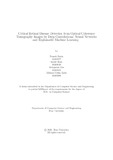| dc.contributor.advisor | Alam, Md. Golam Rabiul | |
| dc.contributor.author | Datta, Pranab | |
| dc.contributor.author | Islam, Saniul | |
| dc.contributor.author | Das, Retuparna | |
| dc.contributor.author | Zabir, Mihiran Uddin | |
| dc.date.accessioned | 2021-12-26T06:36:28Z | |
| dc.date.available | 2021-12-26T06:36:28Z | |
| dc.date.copyright | 2021 | |
| dc.date.issued | 2021-01 | |
| dc.identifier.other | ID 16301177 | |
| dc.identifier.other | ID 16301020 | |
| dc.identifier.other | ID 16301205 | |
| dc.identifier.other | ID 16301198 | |
| dc.identifier.uri | http://hdl.handle.net/10361/15762 | |
| dc.description | This thesis is submitted in partial fulfillment of the requirements for the degree of Bachelor of Science in Computer Science and Engineering, 2021. | en_US |
| dc.description | Cataloged from PDF version of thesis. | |
| dc.description | Includes bibliographical references (pages 49-52). | |
| dc.description.abstract | Retinal disease diagnosis by machine learning can be achieved using Deep Neural
Network based predictors. Use of Explainable Artificial Intelligence (XAI) has the
potential to explain the black box of those neural network models which are used in
identifying critical retinal diseases. Due to lack of explanation in neural networks,
Machine Learning based systems are not well trusted in medical field. People still
have to rely on the doctor’s clarification to come into any conclusion with medical
issues. In our proposed model, we have used several Convolutional Neural Net work (CNN) models leveraging transfer learning to identify some of the critical reti nal diseases such as Choroidal Neovascularization (CNV), Diabetic Macular Edema
(DME), DRUSEN from Optical Coherence Tomography (OCT) images along with
the explanation. For our classification task, we have used four different CNN models
namely which are ResNet 50, inceptionv3, xception, VGG 16. At first, A dataset
of several thousand OCT images consisting of four classes: CNV, DME, DRUSEN,
and Normal were collected. Afterward, The dataset were pre-processed and applied
to our proposed CNN models to classification. We achieved the accuracy gradually
95.20 %, 94.00 %, 96.30 % and 93.30 % by performing the four deep learning model
respectively Inception V3, ResNet50, VGG16, and Xception. Eventually, in order to
understand the results produced by the black box models, we applied a method of
Explainable AI named Layer-wise Propagation (LRP) for a better understanding of
retinal disease detection by the CNN models. To add with, the LRP have analysed
the models with back propagation and focused on the area of the input image based
on the model’s training parameters. To sum up, our proposed model has been able
to perform critical retinal diseases detection as well as the explanation behind the
identification. | en_US |
| dc.description.statementofresponsibility | Pranab Datta | |
| dc.description.statementofresponsibility | Md. Saniul Islam | |
| dc.description.statementofresponsibility | Retuparna Das | |
| dc.description.statementofresponsibility | Mihiran Uddin Zabir | |
| dc.format.extent | 52 Pages | |
| dc.language.iso | en | en_US |
| dc.publisher | Brac University | en_US |
| dc.rights | Brac University theses are protected by copyright. They may be viewed from this source for any purpose, but reproduction or distribution in any format is prohibited without written permission. | |
| dc.subject | Machine Learning | en_US |
| dc.subject | Image classification | en_US |
| dc.subject | Artificial Intelligence | en_US |
| dc.subject | Optical Coherence Tomography | en_US |
| dc.subject | CNN | en_US |
| dc.subject | Inception V3 | en_US |
| dc.subject | Resnet50 | en_US |
| dc.subject | VGG16 | en_US |
| dc.subject | Xception | en_US |
| dc.subject | Black Box | en_US |
| dc.subject | LRP | en_US |
| dc.subject.lcsh | Machine Learning | |
| dc.title | Critical retinal disease detection from optical coherence tomography images by deep convolutional neural network and explainable machine learning | en_US |
| dc.type | Thesis | en_US |
| dc.contributor.department | Department of Computer Science and Engineering, Brac University | |
| dc.description.degree | B. Computer Science | |

